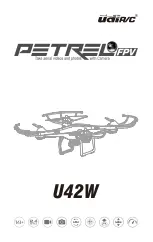
To DIS-ARM is to pull both joysticks down and outwards (towards the sides of the transmitter) and
hold until the motors stop, which will be approx two seconds.
DO NOT DIS-ARM while the drone is in the air – it will stop flying and crash.
Practice first with just the transmitter. You can practice later with the Drone. If you are practising
with the Drone remember to remove the propellers.
Practice a flight with the Transmitter only
A good way to get use to the transmitter is to practice the movements and actions with the
transmitter by itself performing pretend flights.
Perform several pretend flights to learn the procedure.
•
Switches into the correct position (up and away from you)
•
Throttle to zero (down and towards you)
•
Turn on Transmitter
•
Resolve any error messages (generally switch or throttle warnings)
•
Arm Motors (pretend motors arm)
•
Once arms, push throttle to full throttle to climb (pretend drone is flying)
•
Throttle back to the centre to hover
•
Push the right joystick forward to fly forward.
•
While flying forward pull the release switch (inside left) towards you to release the baits.
•
Release right joystick to hover
•
Check both joysticks are centred. If the throttle is not centred they drone may not
automatically land.
•
Pull the left outside switch towards you to engage RTL, and then push back. If you leave the
switch in the RTL position, you will have no directional control of the drone.
•
The drone will now fly back to you and land
•
During the landing, you may need to guide the drone left or right, or forward or backwards
to land in the correct spot.
•
Once the drone has landed DISARM
The important step is to centre the joysticks before engaging RTL
Get comfortable with these steps before risking your drone.
Pre-Flight Checklist
Before flying
ALWAYS
complete the pre-flight checks.
Preflight check
•
Turn on transmitter
•
Check the voltage of transmitter batteries – do not
fly with flat batteries in the transmitter.
•
Check the switches and joysticks of the transmitter
•
Check battery voltage to ensure battery is fully
charged – 25.1 to 25.2v
•
Check to ensure all the cells in the battery have
similar (><0.1v) voltage Approx 4.2v per cell.
•
Check all propellers are not damaged or
unbalanced
•
Check the propellers are screwed on tight
Содержание Matrix KontikiDrone
Страница 24: ......































